Now Accepting Nominations for the 5th Annual Meg Robertson Mobility Award!
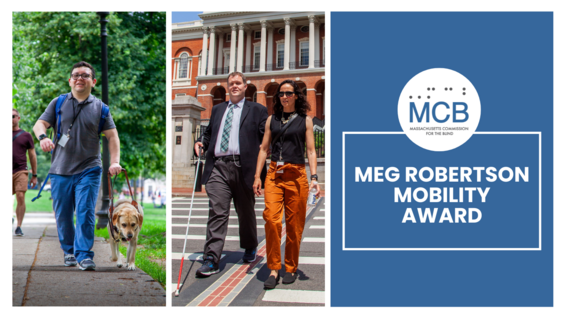
In recognition of retired Orientation and Mobility Director Meg Robertson's more than 30 years of service to the Commonwealth, the Massachusetts Commission for the Blind (MCB) has established the Meg Robertson Mobility Award. This award honors Meg’s tireless dedication, hard work, and advocacy within the blindness community.
The award is open to motivated white cane and dog guide users of all ages and abilities. We are specifically seeking individuals who demonstrate mobility skills at their current level and use their white cane or dog guide to increase their independence.
The nomination form must be completed by a Certified Orientation and Mobility Specialist (COMS) or a National Orientation and Mobility Certificant (NOMC). There are three award categories: Youth, Adult, and DeafBlind Extended Supports (DBES).
Nominations should address the following:
- How has the person’s travel ability with a white cane or dog guide improved since the beginning of their O&M instruction to their current level?
- Where does the person travel with their white cane or dog guide?
- How has O&M instruction impacted their life?
The nomination period for the 5th Annual Meg Robertson Mobility Award is now open. All nominations must be submitted by August 8, 2025. To nominate an individual, please complete the nomination form.
A committee assembled by MCB will review the nominations and vote on the winners. The awards are presented annually at our White Cane Awareness Day Celebration in October.
White Cane History
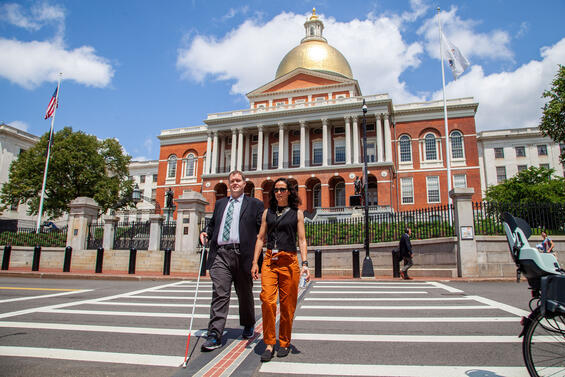
Dating back to biblical times, records show a shepherd's staff was used as a tool for solitary travel. People who were blind used such tools to alert them to obstacles in their path. For centuries, the "cane" was used merely as a tool for travel. It was not until the twentieth century the cane, as we know it today, was promoted as a symbol to alert others the user was blind. This new role for the white cane dates to the decades between the two World Wars, beginning in Europe and then spreading to North America.
In 1921, James Biggs, a photographer from Bristol, England, became blind following an accident. Because he was feeling uncomfortable with the amount of traffic around his home, he painted his walking stick white to be more easily visible.
In North America, the introduction of the white cane didn’t come until ten years later. The Lion’s Club International is credited with establishing the cane’s presence in society in the United States. In 1930, George A. Bonham, President of the Peoria Lions Club (Illinois), introduced the idea of using the white cane with a red band as a means of assisting people who are blind in independent mobility. He got the idea after watching a man who was blind try to cross a busy street using a black cane and recognized the need for increased visibility. The Peoria Lions approved the idea, white canes were made and distributed, and the Peoria City Council adopted an ordinance giving people using a white cane the right-of-way to cross a street. News of the club’s activity spread quickly to other Lions Clubs throughout the United States and people who were blind or had low vision experimented with using white canes. Overwhelming acceptance of the white cane idea by people who were blind and sighted alike quickly gave cane users a unique method of identifying their special need for travel consideration among their sighted counterparts.
In 1931, in France, Guilly d’Herbemont recognized the danger to people who are blind in traffic and launched a national “white stick movement.” She donated 5,000 white canes to people in Paris. Reporting in British newspapers led to a similar movement being sponsored by rotary clubs throughout the United Kingdom. Three months later, the BBC suggested in radio broadcasts people who are blind might be provided with a white stick, which would become universally recognized as a symbol indicating the user was blind or had low vision.
But as World War II was ending and veterans who became blind during battle returned to America, Richard Hoover, a rehabilitation specialist at Valley Forge Army Hospital, further improved the form and use of the white cane to help the veterans return to participatory lifestyles at home. He took the white cane developed by the Lions Club, which was originally made of wood, and went around the hospital blindfolded for a week. During this time, he developed what is now the standard method of long cane training - or the "Hoover Method." The basic technique is to swing the cane from the center of the body back and forth before the feet. The cane should be swept before the rear foot as the person steps.
During this period, the white cane began to make its way into government policy. In 1935, Michigan began promoting the white cane as a visible symbol for people who are blind. In 1936, the City of Detroit passed an ordinance recognizing the white cane. In 1937, Michigan’s Governor signed into law protections for the carrier of the white cane while traveling on the streets of Michigan. Today, all 50 states have laws requiring drivers to yield the right of way to people with white canes, even when they’re not in a crosswalk.
During the early 1960s, several state organizations and rehabilitation agencies serving people who were blind or had low vision urged Congress to proclaim October 15th of each year to be White Cane Safety Day in all fifty states. This event marked a climactic moment in the long campaign of the organized blind movement to gain national recognition for the white cane. On October 6, 1964, a joint resolution of the United States Congress, HR 753, was signed into law authorizing the President of the United States of America to proclaim October 15th of each year as White Cane Safety Day. The resolution read, "Resolved by the Senate and House of Representatives that the President is hereby authorized to issue annually a proclamation designating October 15th as White Cane Safety Day and calling upon the people of the United States of America to observe such a day with appropriate ceremonies and activities." Hours later, President Lyndon B. Johnson made history as the first to proclaim October 15th as White Cane Safety Day.
The Presidential proclamation emphasized the significance of the use of the white cane as both a mobility tool and as a visible symbol. In the first White Cane Proclamation, President Johnson commended people who are blind for the growing spirit of independence and the increased determination to be self-reliant and dignified. He wrote, in part, "A white cane in our society has become one of the symbols of a blind person's ability to come and go on his own. Its use has promoted courtesy and opportunity for mobility of the blind on our streets and highways."
During most years since 1964, the President of the United States has proclaimed October 15th as White Cane Safety Day.
On October 15, 2000, President Bill Clinton again reminded us of the history of the white cane as a tool and symbol of blindness. In his 2000 White Cane Safety Day Proclamation, he wrote, in part, "With proper training, people using the white cane can enjoy greater mobility and safety by determining the location of curbs, steps, uneven pavement, and other physical obstacles in their path. The white cane has given them the freedom to travel independently to their schools and workplaces and to participate more fully in the life of their communities. It reminds us that the only barriers against people with disabilities are discriminatory attitudes and practices that our society has too often placed in their way. As we observe White Cane Safety Day, 2001, let us recall the history of the white cane, its emergence as a tool and a symbol through history, a staff of independence. Let us also recall the events that have permitted us to celebrate October 15th as White Cane Safety Day.”
Sources: Lions Clubs International, Philip Strong via New Jersey Council of the Blind
Share Your White Cane Story

MCB educates and provides information to the public on the abilities of people who are legally blind in the Commonwealth. As part of this awareness campaign, MCB promotes people who are positive, productive, and independent members of the blindness community. This information is often provided through written stories, photographs, and audio-visual presentations.
You can play a role in public education efforts at MCB as we attempt to break down the attitudinal barriers that limit opportunities for success among people who are legally blind.
Related Laws

Massachusetts General Laws Chapter 90, Section 14A - Protection of blind pedestrians crossing or attempting to cross ways
Whenever a totally or partially blind pedestrian, guided by a guide dog or carrying in a raised or extended position a cane or walking stick which is white in color or white tipped with red, crosses or attempts to cross a way, the driver of every vehicle approaching the place where such pedestrian is crossing or attempting to cross shall bring his vehicle to a full stop, and before proceeding shall take such precautions as may be necessary to avoid injuring such pedestrian. A person who owns an animal shall restrain and control such animal on a leash when in proximity to a guide dog that is on a public or private way. Nothing contained in this section shall be construed to deprive any totally or partially blind person, not carrying such a cane or walking stick or not being guided by a dog, of the rights and privileges conferred by law upon pedestrians crossing ways, nor shall the failure of such blind person to carry a cane or walking stick or to be guided by a guide dog while on the ways of this commonwealth be held to constitute or be evidence of contributory negligence. Whoever violates any provision of this section shall be punished by a fine of no less than one hundred nor more than five hundred dollars.
Massachusetts General Laws Chapter 272, Section 98A - Physically handicapped persons with dog guides; public places or conveyances; charges or fares; penalties
Notwithstanding any other provision of law, any blind person, or deaf or hearing handicapped person, or other physically handicapped person accompanied by a dog guide, shall be entitled to any and all accommodations, advantages, facilities and privileges of all public conveyances, public amusements and places of public accommodation, within the commonwealth, to which persons not accompanied by dogs are entitled, subject only to the conditions and limitations applicable to all persons not accompanied by dogs, and no such blind person, or deaf or hearing handicapped, or other physically handicapped person shall be required to pay any charge or fare for or on account of the transportation on any public conveyance for himself and such dog so accompanying him in addition to the charge or fare lawfully chargeable for his own transportation. Whoever deprives any blind person, or deaf or hearing handicapped person, or other physically handicapped person of any right conferred by this section shall be punished by a fine of not more than three hundred dollars and shall be liable to any person aggrieved thereby for such damages as are set forth in section five of chapter one hundred and fifty-one B; provided, however, that such civic forfeiture shall be of an amount not less than one hundred dollars.
Let's Walk Together: Safe Guiding Techniques for People with Vision Loss & Intellectual Disabilities
Video: Let's Walk Together: Safe Guiding Techniques for People with Vision Loss & Intellectual Disabilies
Skip this video Let's Walk Together: Safe Guiding Techniques for People with Vision Loss & Intellectual Disabilies.Types of White Canes
Did you know? White canes can be made of aluminum, fiberglass, or carbon fiber. They can weigh as little as seven ounces. Recommendations are based on a number of factors, including the type of visual impairment, age, height, and other specific needs as assessed by a Certified Orientation and Mobility Specialist (COMS).
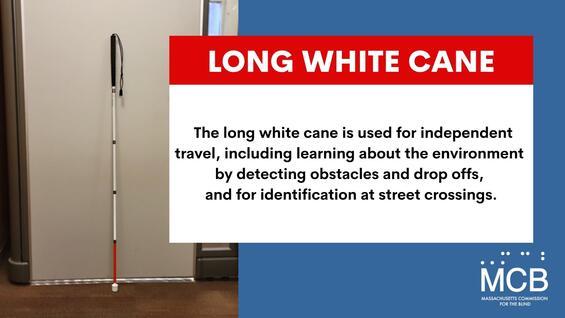
Long White Cane - The long white cane has a red marking at the bottom. Cane tips may vary in size and type. This cane is used for independent travel, learning about the environment, detecting obstacles and drop offs, and for identification at street crossings.

Identification (ID) Cane - The identification (ID) cane has a red marking at the bottom and a rubber trip. This cane identifies the user as a person who is blind or has low vision but has usable travel vision. The cane can assist with depth perception on stairs or curbs in familiar areas and visual balance but does not offer protection against unexpected obstacles.

Short Cane for Identification (ID) - The short white ID cane is designed to identify n person as blind or has low vision but has usable travel vision. This cane assists with depth perception on stairs or curbs in familiar areas and visual balance but does not offer protection against the unexpected obstacles.

Adaptive Mobility Device (AMD) - “Adaptive mobility devices are intended to provide protection; in some cases, they are used as a pre-cane. They are particularly useful as a drop off detector and for those with balance issues.” (Source: Ambutech) AMDs are still marked with red and white for identification purposes.

A wide variety of cane tips provide smoother operation and more durability. Each tip has pros and cons.
- Pencil tip
- Pros: Good feedback and lightness make this tip a good choice for people who have problems moving their wrists for long periods.
- Cons: The long, thin tip tends to get stuck in cracks in the sidewalk.
- Roller tip
- Pros: Rolls over cracks in the sidewalk, making for a smoother walk.
- Cons: Greater weight can add to wrist fatigue; doesn’t provide as much feedback to the traveler about small changes in the terrain.
- Marshmallow tip
- Pros: The thick tip won’t get stuck in cracks easily.
- Cons: The tip is heavy and can cause wrist fatigue over time.
- Metal glide
- Pros: Very light; glides easily over cracks.
White Cane Training

People experiencing vision loss encounter many new challenges. Certified Orientation and Mobility Specialists (COMS) provide individualized travel training programs within one’s home, workplace and community. Instruction begins with an assessment of the person's travel needs, motivation, and visual and physical abilities. Based upon this assessment, a training program is developed with the goal of maximizing independence. Or, for the more experienced traveler, training may focus on providing orientation to a new environment, such as a new home, workplace, or college campus. Contact your MCB counselor to inquire about Orientation and Mobility training.
COMS also offer consultation services on:
- Advocacy
- Accessibility-related matters, such as accessible pedestrian signals, safe travel routes, and environmental barriers which impact pedestrians who are legally blind.
- In-service training on blindness etiquette to professionals, such as businesses, councils on aging, assistive living residences, residential programs, and more.
How To Get a White Cane

MCB provides one free white cane to each Massachusetts resident who is legally blind through our Orientation and Mobility Department. Contact your MCB counselor for more information, including how to purchase additional or replacement canes.
Additionally, the National Federation for the Blind (NFB) has a Free White Cane Program to ensure everyone who is blind has access to a white cane regardless of their ability to cover the cost.
To request a white cane from NFB:
- Free White Cane Online Application
- Free White Cane Application (PDF); please mail the completed PDF application to Free White Cane Program, National Federation of the Blind, 200 East Wells Street at Jernigan Place, Baltimore, Maryland 21230
Any person who is blind in the fifty states, the District of Columbia, and Puerto Rico can request a cane for their personal use. Requests can be made as often as every six months.
How to Guide a Person with Vision Loss
Video: How to Guide a Person with Vision Loss
Skip this video How to Guide a Person with Vision Loss.Dog Guides
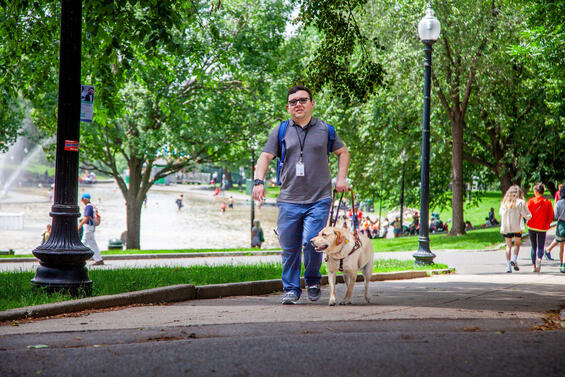
Orientation and Mobility training is an essential part of preparing people who are legally blind to be successfully partnered with a dog guide. MCB does not provide dog guides, but our counselors can assist with connecting interested consumers with resources. After a consumer is paired with a dog guide, Certified Orientation and Mobility Specialists are available to provide route orientation.
Become a Certified Orientation and Mobility Specialist (COMS)
UMass Boston’s Vision Studies MEd was ranked as one of the Best Online Graduate Education Programs by U.S. News & World Report. This program focuses on training professionals to assist people with visual impairment to achieve their goals, including high-quality education, fulfilling employment, and safe, independent travel. It’s designed for teachers and other professionals who want to work with people with visual impairment and help them lead safe, productive, and independent lives. Explore cutting-edge learning technologies and gain practical hands-on experience through fieldwork. Apply these skills to assist people of all ages in different settings — school districts; veterans rehabilitation hospitals; nonprofits; state, federal, and private agencies; and more. This program prepares you to receive initial licensure to teach in Massachusetts and prepares you to sit for national professional exams through the Academy for Certification of Vision Rehabilitation & Education Professionals.
The program consists of four tracks: Orientation & Mobility (O&M), Teachers of Students with Visual Impairments (TVI), and Vision Rehabilitation Therapy (VRT), and Assistive Technology for Individuals with Visual Impairment (AT).
The O&M track teaches you how to evaluate needs of adults and children with visual impairments. You’ll learn how to teach them how to use equipment, such as the long cane, and low vision aids, as well as the integration of a professionally trained dog guide so they may orient themselves and travel safely with confidence. The program prepares you to sit for the national professional examination in O&M offered by the Academy for Certification of Vision Rehabilitation and Education Professionals (ACVREP).
2023 MCB White Cane Awareness Day Celebration
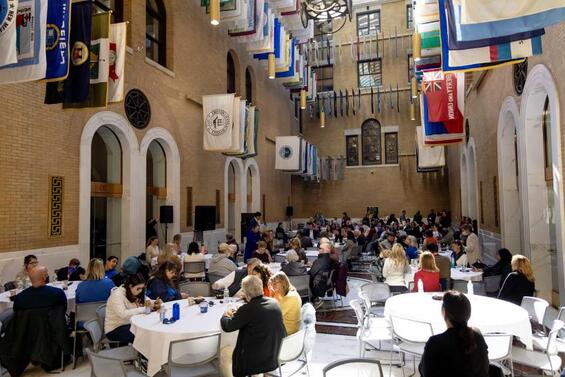
The photograph is courtesy of Charlotte Tuminelli.
More than 200 consumers, their families and friends, community partners, stakeholders, advocates, and lawmakers filled the Massachusetts State House's Great Hall on Friday, October 13, 2023, to celebrate White Cane Awareness Day with the Massachusetts Commission for the Blind.
Hosted by Orientation and Mobility Director Ally Bull, Commissioner John Oliveira opened the event followed by Secretary Walsh reading the Governor’s proclamation. Senator Robyn Kennedy and Representative Jay Livingstone, co-chairs of the Joint Committee on Children, Families, and Persons with Disabilities, talked about making our communities safer, more accessible, and welcoming to all. Kyle Robidoux, a tireless advocate who has focused his professional and personal career on building community, delivered the keynote speech, followed by the presentation of the 3rd annual Meg Robertson Mobility Award. The youth recipient, Nikolas Hourican, was surprised by Beverly Mayor Michael Cahill who attended the event and announced October 13, 2023, as Nikolas Hourican Day in the City of Beverly.
MCB also presented Certificates of Appreciation to Nicole Spriggs at the Massachusetts Registry of Motor Vehicles (RMV) and Jerry Kelleher at the Massachusetts Department of Transportation (MassDOT) who help promote white cane awareness throughout October on MassDOT billboards across the Commonwealth and a public service announcement on the monitors at RMV Service Centers.
Listen to an audio recording of the event courtesy of Talking Information Center.